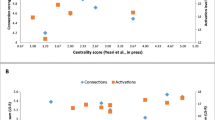Abstract
Reading is a complex cognitive process wherein learners acquire new information and consolidate their knowledge. Readers create a mental representation for a given text by processing relevant words that, along with prior inferred concepts, become activated and establish meaningful associations. Our automated model of comprehension (AMoC) uses an automated approach for simulating the ways in which learners read and conceptualize by considering both text-based information consisting of syntactic dependencies, as well as inferred concepts from semantic models. AMoC makes use of cutting edge Natural Language Processing techniques, transcends beyond existing models, and represents a novel alternative for modeling how learners potentially conceptualize read information. This study presents side-by-side comparisons of the results generated by our model versus the ones generated by the Landscape model.
Access this chapter
Tax calculation will be finalised at checkout
Purchases are for personal use only
Similar content being viewed by others
References
Kintsch, W., Welsch, D.M.: The Construction-Integration Model: A Framework for Studying Memory for Text, p. 21. Institute of Cognitive Science, Boulder (1991)
van den Broek, P., Young, M., Tzeng, Y., Linderholm, T.: The landscape model of reading. In: van Oostendorp, H., Goldman, S.R. (eds.) The Construction of Mental Representations During Reading, pp. 71–98. Erlbaum, Mahwah (1999)
McNamara, D.S., Magliano, J.: Toward a comprehensive model of comprehension. Psychol. Learn. Motiv. 51, 297–384 (2009)
Dascalu, M., Dessus, P., Bianco, M., Trausan-Matu, S., Nardy, A.: Mining texts, learner productions and strategies with ReaderBench. In: Peña-Ayala, A. (ed.) Educational Data Mining. SCI, vol. 524, pp. 345–377. Springer, Cham (2014). https://doi.org/10.1007/978-3-319-02738-8_13
Trausan-Matu, S., Stahl, G., Sarmiento, J.: Polyphonic support for collaborative learning. In: Dimitriadis, Y.A., Zigurs, I., Gómez-Sánchez, E. (eds.) CRIWG 2006. LNCS, vol. 4154, pp. 132–139. Springer, Heidelberg (2006). https://doi.org/10.1007/11853862_11
Miller, G.A.: WordNet: a lexical database for English. Commun. ACM 38(11), 39–41 (1995)
Landauer, T.K., Dumais, S.T.: A solution to Plato’s problem: the latent semantic analysis theory of acquisition, induction and representation of knowledge. Psychol. Rev. 104(2), 211–240 (1997)
Mikolov, T., Sutskever, I., Chen, K., Corrado, G., Dean, J.: Distributed representations of words and phrases and their compositionality. In: Advances in Neural Information Processing Systems, pp. 3111–3119 (2013)
Mikolov, T., Chen, K., Corrado, G., Dean, J.: Efficient estimation of word representation in vector space. In: Workshop at ICLR, Scottsdale (2013)
Manning, C.D., Surdeanu, M., Bauer, J., Finkel, J., Bethard, S.J., McClosky, D.: The Stanford CoreNLP Natural Language Processing toolkit. In: 52nd Annual Meeting of the Association for Computational Linguistics: System Demonstrations, pp. 55–60. ACL, Baltimore (2014)
Page, L., Brin, S., Motwani, R., Winograd, T.: The PageRank citation ranking: bringing order to the web. Stanford InfoLab (1999)
Britton, B.K., Graesser, A.C.: Models of understanding text. In: Britton, B.K., Graesser, A.C. (eds.) Models of Understanding Text. Psychology Press, New York (1995)
Acknowledgment
The work presented in this paper was funded by the European Funds of Regional Development with the Operation Productivity Program 2014–2020 Priority Axe 1, Action 1.2.1 D-2015, “Innovative Technology Hub based on Semantic Models and High Performance Computing” Contract no. 6/1 09/2016.
Author information
Authors and Affiliations
Corresponding author
Editor information
Editors and Affiliations
Rights and permissions
Copyright information
© 2018 Springer Nature Switzerland AG
About this paper
Cite this paper
Dascalu, M., Paraschiv, I.C., McNamara, D.S., Trausan-Matu, S. (2018). Towards an Automated Model of Comprehension (AMoC). In: Pammer-Schindler, V., Pérez-Sanagustín, M., Drachsler, H., Elferink, R., Scheffel, M. (eds) Lifelong Technology-Enhanced Learning. EC-TEL 2018. Lecture Notes in Computer Science(), vol 11082. Springer, Cham. https://doi.org/10.1007/978-3-319-98572-5_33
Download citation
DOI: https://doi.org/10.1007/978-3-319-98572-5_33
Published:
Publisher Name: Springer, Cham
Print ISBN: 978-3-319-98571-8
Online ISBN: 978-3-319-98572-5
eBook Packages: Computer ScienceComputer Science (R0)




